RN HESI NUTRITION
Total Questions : 49
Showing 25 questions, Sign in for moreThe nurse is preparing the client for discharge and discussing home medications. What home medications may affect the amount of insulin needed by the client? Select all that apply.
Explanation
Choice A rationale: St. John's Wort is an herbal supplement that can interact with various medications, including insulin, and may alter blood glucose levels. It can reduce the effectiveness of insulin, leading to decreased blood glucose control. It is essential for the client to inform the healthcare provider about any use of St. John's Wort to adjust the insulin regimen accordingly.
Choice B rationale: Corticosteroids can increase blood glucose levels by promoting insulin resistance and inhibiting insulin action. Clients with diabetes may require adjustments in their insulin dosage while taking corticosteroids to prevent hyperglycemia.
Choice Crationale: Ibuprofen is a nonsteroidal anti-inflammatory drug (NSAID) that does not typically have a direct impact on blood glucose levels in people with diabetes.
Choice D: Oral contraceptives, specifically combination hormonal contraceptives containing estrogen and progestin, can impact blood glucose levels. They may lead to insulin resistance and, in some cases, increase blood glucose levels. The healthcare provider may need to adjust the insulin dosage for better glycemic control.
Choice E rationale: Epinephrine is a hormone that may transiently increase blood glucose levels in response to stress, but it is not a home medication that the client would be taking regularly.
A female client with haemorrhoids tells the nurse that she understands the need to avoid eating nuts and seeds to prevent inflammation. How should the nurse respond?
Explanation
Choice A
Explain the benefits of a high fibre diet is not correct response. While a high fibre diet can indeed be beneficial for individuals with haemorrhoids by promoting regular bowel movements and reducing strain during defecation, the immediate concern here is addressing the client's understanding about avoiding nuts and seeds. This information could be provided as a follow-up after confirming the client's understanding in response to option B.
Choice B
Confirm that these foods should be avoided is the correct response. In this situation, the nurse's first response should be to confirm the client's understanding and provide accurate information about the need to avoid certain foods. Nuts and seeds can be challenging to digest and may lead to irritation and inflammation in individuals with haemorrhoids. Confirming the client's understanding and providing guidance aligns with the nurse's role in patient education and care.
Choice C
Encourage soft foods such as yogurt is not the correct response. Encouraging soft foods like yogurt is a reasonable suggestion for someone with haemorrhoids, as soft foods are generally easier to digest and less likely to cause irritation. However, the client's statement was specifically about avoiding nuts and seeds. While this choice might be relevant, it doesn't directly address the client's statement.
Choice D
Suggest that the client also avoid fruit skins is not the correct response. This option is not directly related to the client's concern about nuts and seeds. Fruit skins generally contain dietary fibre, which can be beneficial for maintaining regular bowel movements. While some individuals might find that certain fruits with tough skins could exacerbate their haemorrhoid symptoms, this advice might be better suited for a separate discussion about dietary choices rather than as a direct response to the client's statement.
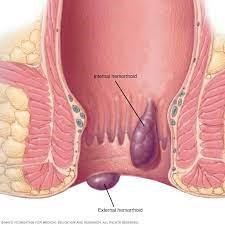
The nurse is developing a food safety educational class for a group of parents. Which type of food is most likely to pose a threat of food poisoning after being stored in a refrigerator at 40°F (4.4°C) or below for more than two days?
Explanation
Choice A
Opened package of hot dogs is not correct. Hot dogs are processed and often contain preservatives that help extend their shelf life. However, it's still important to follow proper storage guidelines to ensure their safety.
Choice B
Packaged of uncooked lamb chops is not correct. Uncooked meats are generally safe if stored properly. The main concern arises when cooking and handling them, as raw meats can potentially cross-contaminate other foods if proper sanitation measures are not followed.
Choice C
Opened package of deli sliced meat is correct. Among the options provided, an opened package of deli sliced meats (option C) is most likely to pose a threat of food poisoning after being stored in a refrigerator at 40°F (4.4°C) or below for more than two days.
Deli sliced meats are considered a high-risk food for bacterial growth and foodborne illnesses. When meats are sliced and exposed to air, they have a larger surface area, making them more susceptible to bacterial contamination. While the refrigerator temperature of 40°F (4.4°C) helps slow down bacterial growth, it doesn't completely prevent it, especially if the food has been stored for an extended period of time.
Choice D
Ground-up hamburger raw meat is not correct. Similar to uncooked lamb chops, raw ground meat is generally safe when stored properly and handled with care. However, ground meats do have a larger surface area that can allow bacteria to grow more easily, which is why safe cooking practices are important.
A client who is receiving antineoplastic chemotherapy has lost 25% of total body weight and is having difficulty eating because of stomatitis. In planning care for this client which diet should the nurse recommend?
Explanation
Choice A
Low residue diet is incorrect. A low residue diet is typically recommended for individuals with gastrointestinal conditions like inflammatory bowel disease or diverticulitis. This diet limits high-fibre foods to reduce bowel movements and ease digestive stress. However, it might not be the best option for a client with stomatitis who is struggling to eat due to mouth pain.
Choice B
Mechanical soft diet is incorrect. A mechanical soft diet includes foods that are soft and easy to chew, but they aren't necessarily pureed. While this diet might be more comfortable to eat for some individuals, a client with severe stomatitis might still experience pain while chewing. A pureed diet is a step further in terms of texture modification and can be better tolerated by someone with significant mouth pain.
Choice C
Pureed regular diet is correct. Stomatitis is inflammation of the mouth and can cause pain and discomfort, making it difficult for the client to eat. In this case, a pureed regular diet would be the most suitable choice.
Choice D
High protein soft diet is incorrect. While a high protein diet is important for recovery, healing, and maintaining muscle mass, the texture of the diet is equally important for someone with stomatitis. A high protein soft diet might still involve foods that are challenging to eat due to mouth pain, and therefore, a pureed diet would be a better option in this case.
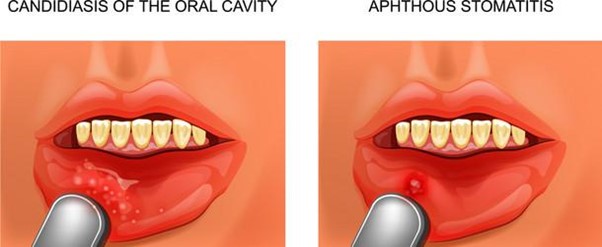
A client who haemorrhaged following surgery has a haemoglobin of 10 g/dl. (6.21 mmol/L) and a haematocrit of 36% (0.36 volume fraction) 48 hours later. The client has now progressed to a soft diet and is eating oatmeal for breakfast. Which beverage should the nurse encourage this client to drink to increase iron intake?
Reference Ranges
Haemoglobin (Hgb) [Reference Range: Male: 14 to 18 g/dL or 8.7 to 11.2 mmol/L]
Haematocrit (Hct) [Reference Range: Male: 42% to 52% or 0.42 to 0.52 volume fraction)
Explanation
Choice A
Coffee is incorrect. Coffee can inhibit iron absorption and is not a good choice for increasing iron intake.
Choice B
Hot tea is incorrect. Similar to coffee, some compounds in tea can interfere with iron absorption, making it less optimal for increasing iron intake.
Choice C
Orange juice is correct. Orange juice is a great choice as it is high in vitamin C, which can enhance the absorption of iron from plant-based sources like oatmeal. The vitamin C in orange juice helps convert non-heme iron into a form that is more easily absorbed by the body.
Choice D
Apple juice is incorrect. While apple juice is a source of fluids, it doesn't provide the same level of vitamin C as orange juice, which is important for enhancing iron absorption.

The nurse is caring for an older client with that is exhibiting signs of confusion. Which intervention should the nurse implement?
Explanation
Choice A
Offering water to the client hourly is not appropriate. While staying hydrated is important for overall health, offering water hourly might not be necessary unless there is a specific indication of dehydration. However, monitoring the client's fluid intake and output is a good approach.
Choice B
Reducing dairy product intake is not appropriate. Dairy product intake is not typically associated with sudden onset confusion. Reducing dairy product intake would not be the primary intervention for addressing confusion.
Choice C
Increasing daily sodium intake is not appropriate. Increasing sodium intake is unlikely to be the appropriate intervention for confusion unless there is a specific medical reason for it. Moreover, excessive sodium intake can have negative health consequences.
Choice D
Reviewing the intake and output record is appropriate. Confusion in an older client can be caused by various factors, including medical conditions, medication side effects, dehydration, and electrolyte imbalances. Reviewing the intake and output record (option D) is a reasonable intervention to gather more information about the client's fluid balance and hydration status. This can help the nurse assess whether the confusion might be related to dehydration or electrolyte imbalances.
Which client is at greatest risk for aspiration?
Explanation
Choice A
Client with a nasogastric tube to low, intermittent suction is not correct. While there is a risk of aspiration with a nasogastric tube in place, the tube is intended to help drain stomach contents, reducing the risk of aspiration. However, if the tube is not properly positioned or managed, there could still be some risk.
Choice B
Client who has sensory aphasia and is receiving a clear liquid diet is correct. Sensory aphasia refers to a language disorder that affects a person's ability to understand language and communication. This client may have difficulty swallowing safely and effectively, which increases the risk of aspiration. Additionally, a clear liquid diet consists of thin liquids that are more likely to be aspirated compared to thicker fluids.
Choice C
Client receiving 30% oxygen via a non-rebreather face mask is not correct. Oxygen therapy can increase the risk of drying the airways and potentially increasing the risk of aspiration, but if the oxygen mask is properly fitted and humidified, the risk may be minimized.
Choice D
Client experiencing dysphagia who is prescribed a full liquid diet is not correct. Dysphagia refers to difficulty swallowing, which can increase the risk of aspiration. However, a full liquid diet includes thicker liquids that are less likely to be aspirated compared to thin liquids. Still, the risk of aspiration exists, especially if the client has severe dysphagia.
A client who is training for a first marathon arrives at the clinic reporting an increase in the frequency of leg cramps. Which recommendation should the nurse provide to help decrease the frequency of leg cramps?
Explanation
Choice A
Drinking a litre of water during and after running is not appropriate: While hydration is important, consuming plain water might not be sufficient to address electrolyte imbalances that can contribute to leg cramps. Drinking excessive amounts of water without electrolyte replacement can even lead to a dilution of electrolyte levels.
Choice B
Consuming a sports drink before and during training is appropriate. Sports drinks are formulated to provide not only hydration but also electrolytes like sodium, potassium, and sometimes magnesium. These electrolytes are important for proper muscle function and can help prevent cramps. Consuming a sports drink before and during training can help maintain electrolyte balance and reduce the risk of leg cramps.
Choice C
Eating a high carbohydrate meal after running is not appropriate. Carbohydrates are important for refuelling muscles after exercise, but this recommendation doesn't directly address the issue of leg cramps during training. Electrolytes like sodium, potassium, and magnesium play a role in muscle function and can help prevent cramps.
Choice D
Avoid drinking alcohol forty-eight hours before training is not appropriate. While avoiding alcohol before training is generally a good idea for hydration and performance reasons, it doesn't specifically address the issue of leg cramps. Electrolyte balance is more directly related to muscle cramping.
A client with glomerulonephritis is preparing for discharge and asks the nurse which kind of diet to follow upon returning home. Which dietary teaching should the nurse include in the discharge instructions?
Explanation
Choice A
Following low carbohydrate diet with low glycaemic index foods is incorrect. This recommendation is not specifically related to the management of glomerulonephritis. While managing carbohydrate intake might be relevant for individuals with diabetes, it's not the primary focus for someone with kidney inflammation.
Choice B
Eating a high protein diet three times a day is incorrect: While protein is important for overall health and recovery, a high protein diet might not be the best recommendation for someone with compromised kidney function. Excessive protein intake could potentially put additional strain on the kidneys.
Choice C
Avoiding foods high in potassium is correct. Examples of foods high in potassium that the client should be cautious about include bananas, oranges, potatoes, tomatoes, spinach, and other fruits and vegetables. Glomerulonephritis is a condition involving inflammation of the glomeruli in the kidneys, which can affect kidney function and the regulation of electrolytes, including potassium. In glomerulonephritis, the kidneys might have difficulty filtering and excreting excess potassium, leading to a potential build-up of potassium in the blood (hyperkalaemia).
Choice D
Restricting sodium rich foods and excessive oral fluids is incorrect. This recommendation aligns more closely with managing fluid retention and blood pressure, which can be relevant for individuals with kidney issues. However, the primary concern in glomerulonephritis is often potassium balance, making the recommendation to avoid high potassium foods more pertinent.
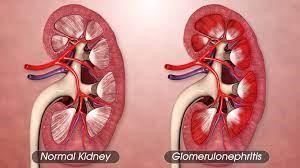
A malnourished child is receiving several nutritional supplements. Which statement by the child indicates to the nurse that an adequate amount of Vitamin A is being provided?
Explanation
Choice A
"The bruises on my arms are all gone." This statement is incorrect. Bruising can be influenced by various factors, including platelet levels and clotting factors, but it is not a specific sign of Vitamin A deficiency.
Choice B
"My feet don't tingle like they used to. “This statement is incorrect. Tingling feet might be related to nerve function or circulation, but it is not a direct symptom of Vitamin A deficiency.
Choice C
"I can see at night when I wake up now. “This statement is correct. Vitamin A is essential for maintaining good vision, especially in low-light conditions. Deficiency of Vitamin A can lead to a condition called night blindness, where individuals have difficulty seeing in low light. Therefore, the statement "I can see at night when I wake up now" (option C) indicates that an adequate amount of Vitamin A is being provided.
Choice D
"My tummy seems so much smaller now. “This statement is incorrect. Changes in tummy size are not typically related to Vitamin A deficiency. Vitamin A deficiency is more closely associated with symptoms related to vision and immune function.

The nurse is admitting an older client with possible malnutrition. Which parameters are most indicative of the client's nutritional status?
Explanation
Choice A
24-hour food recall, food preferences, and allergies is incorrect. While these factors are important for understanding the client's dietary habits and possible dietary restrictions, they do not directly provide information about the client's current nutritional status or overall nutritional health.
Choice B
Body mass index (BMI) and serum albumin level is correct. Body mass index (BMI) and serum albumin level are commonly used parameters to assess a client's nutritional status. These measures provide valuable information about the client's weight, muscle mass, and protein status. Let's break down the options:
Choice C
Triceps skin fold and mid-arm circumference is incorrect. These measurements can provide information about the client's body composition and muscle mass. However, they are not as commonly used as BMI and serum albumin level for assessing nutritional status.
Choice D
Weight loss history and body surface area (BSA) is incorrect. Weight loss history is relevant for understanding changes in the client's weight over time, which can indicate potential malnutrition. However, it's not as comprehensive as BMI, which considers both weight and height. Body surface area (BSA) is not typically used to assess nutritional status.
A young adult client with a history of iron deficiency anaemia has a haemoglobin of 10.5 g/dL (6.52 mmol/L). Which food choice should the nurse recommend to this client?
Reference Range
Haemoglobin (Hgb) [Reference Range: Male: 14 to 18 g/dL or 8.7 to 11.2 mmol/L]
Explanation
Choice A
Broccoli is appropriate recommendation. Given the client's history of iron deficiency anaemia and the current haemoglobin level below the reference range, it's important to recommend foods that are good sources of iron. Among the options provided, broccoli is the most suitable choice. Iron from plant-based sources (non-heme iron) might be less easily absorbed than iron from animal sources (heme iron), but combining them with foods high in vitamin C can enhance iron absorption. Broccoli is a vegetable that contains both iron and vitamin C, making it a favourable choice to support the client's iron intake and help address the anaemia.
Choice B
Carrots are inappropriate. While carrots are a nutritious vegetable, they are not particularly high in iron.
Choice C
Cheddar cheese is inappropriate. Dairy products like cheddar cheese are not significant sources of iron.
Choice D
Whole milk is inappropriate. Whole milk is not a significant source of iron either. Additionally, calcium in milk might hinder iron absorption if consumed together.
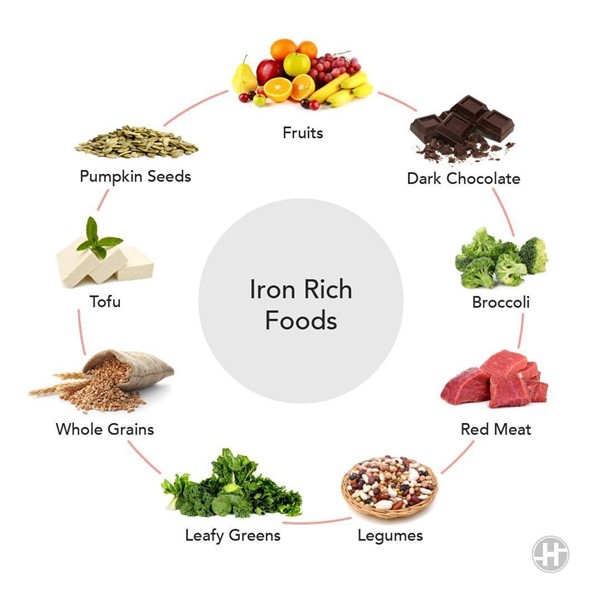
The nurse is reviewing a nutrition plan with a client newly diagnosed with hypertension. Which statement by the client indicates an understanding of the Dietary Approaches to Stop Hypertension (DASH) diet?
Explanation
Choice A
The consumption of dairy-based products should be eliminated from the diet. The statement is false Dairy products, especially low-fat or fat-free options, are included in the DASH diet as sources of calcium and other important nutrients. The DASH diet encourages moderation rather than elimination of dairy.
Choice B
The consumption of protein products should come from lean meats, nuts, and dried beans. The statement is correct. The DASH diet encourages including protein sources that are low in saturated fat and high in nutrients. Lean meats, nuts, and dried beans are examples of protein sources that fit this criterion.
Choice C
The consumption of bread products should be gluten-free. The statement is false The DASH diet does not specifically focus on gluten-free options. It emphasizes whole grains as a source of fibre, which is beneficial for heart health.
Choice D
The consumption of fruit and/or vegetables should total between 4 to 6 servings. The statement is false The DASH diet actually encourages a higher intake of fruits and vegetables, aiming for 8 to 10 servings per day. These foods are rich in potassium, magnesium, and fibre, which contribute to the diet's blood pressure-lowering effects.
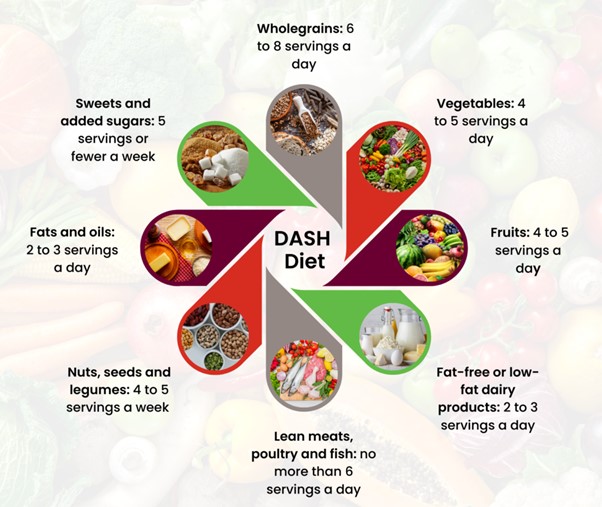
A client has a serum sodium level of 155 mEq/L (155 mmol/L). The nurse should encourage the client to make which selection from the lunch menu? Reference Range
Sodium [Reference Range: Adult 136 to 145 mEq/L or 136 to 145 mmol/L]
Explanation
Choice A
Canned cream of mushroom soup, tuna salad, and water is inappropriate. Canned soups and processed foods like canned cream soups can be high in sodium. Tuna salad might also have added salt.
Choice B
B. Bacon, lettuce, and tomato sandwich, grapes, and skim milk is the appropriate selection. A serum sodium level of 155 mEq/L (155 mmol/L) is higher than the normal reference range (136 to 145 mEq/L or 136 to 145 mmol/L), indicating hypernatremia or high blood sodium levels. In this case, it's important for the client to choose foods that are lower in sodium to help manage their sodium intake.
Choice C
Taco salad, refried beans, low-fat ice cream, and coffee is inappropriate. Taco salad can contain salty ingredients, and refried beans can also be high in sodium. Processed meats and sauces used in tacos can contribute to sodium intake.
Choice D
Chicken salad on toast, fruit-flavoured yogurt, and iced tea is inappropriate. Chicken salad and some breads might contain added salt. Fruit-flavoured yogurts can also have added sugars, and iced tea can vary in sodium content depending on how it's prepared.
An adult woman with a body mass index (BMI) of 21 tells the nurse that she wants to lose 10 pounds (4.5 kg). Which intervention is most important for the nurse to implement?
Explanation
Choice A
Describing the value of eating smaller portion sizes is not appropriate. While portion control is important, this advice alone might not address the overall dietary quality and exercise component necessary for effective weight loss.
Choice B
Encouraging a well-balanced diet and moderate exercise is appropriate. This intervention focuses on promoting healthy and sustainable weight loss. A well-balanced diet helps ensure that the client is getting all the necessary nutrients while aiming for a calorie deficit for weight loss. Moderate exercise complements dietary changes and contributes to overall health and weight management.
Choice C
Exploring the reasons, the client wants to lose weight is inappropriate. While understanding the client's motivations is valuable, this doesn't directly provide guidance on how to achieve the goal of losing 10 pounds.
Choice D
Determining if the client has a history of anorexia is inappropriate. While assessing for eating disorders is important in general, assuming there's no indication of anorexia, the focus should be on providing guidance for safe and effective weight loss.
While assessing placement of a nasogastric tube (NGT), the nurse aspirates cloudy green fluid into a syringe. Which intervention should the nurse implement?
Explanation
Choice A
Sending fluid specimen to the lab should be implemented. Cloudy green fluid aspirated from a nasogastric tube (NGT) can indicate that the tube is in the wrong place, likely in the respiratory tract (trachea) instead of the gastrointestinal tract (stomach). The green colour suggests the presence of bile, which is normally found in the stomach but not in the respiratory tract. This is a serious situation that requires immediate attention.
The most appropriate intervention in this case is to send the fluid specimen to the lab for analysis. This is important for confirmation of the content and to guide further steps. The nurse should also consult the healthcare provider to determine the appropriate course of action, which might involve removing and reinserting the NGT correctly.
Choice B
Withdrawing the NGT and reinsert should not be implemented. If the NGT is in the wrong place, reinserting it without further assessment could worsen the situation. The nurse should not reinsert the NGT until the correct placement is confirmed.
Choice C
Connecting the NGT to wall suction should not be implemented. Connecting the NGT to wall suction without verifying its placement could cause harm, especially if the tube is in the respiratory tract.
Choice D
Determine pH value of specimen should not be implemented. While assessing the pH of aspirated fluid can help confirm the location of the NGT, sending the specimen to the lab for analysis is a more comprehensive action in this situation, as it allows for more detailed examination and guidance for appropriate next steps.
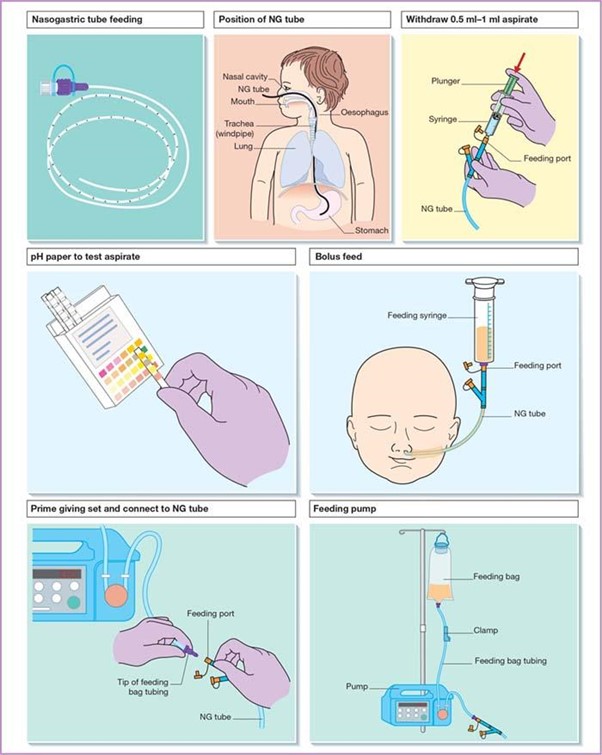
The nurse is caring for a client who has been diagnosed with malnutrition. Which finding supports the medical diagnosis?
Explanation
Choice A
Body mass index (BMI) of 17 is the correct finding. A low Body Mass Index (BMI) is a common indicator of malnutrition. BMI is a measurement that considers a person's weight in relation to their height. A BMI of 17 suggests that the person is underweight, which can be indicative of malnutrition. Malnutrition is characterized by inadequate intake of calories, protein, vitamins, and minerals that are essential for maintaining health and well-being.
Choice B
Decrease in appetite is not correct finding. While a decrease in appetite might contribute to malnutrition, it's a symptom rather than a definitive indicator.
Choice C
Dry mucosal membranes are not the correct finding. Dry mucosal membranes can be related to dehydration or other conditions, but they are not specific enough to confirm malnutrition on their own.
Choice D
Weight of 227 pounds (103 kg) is not the correct finding. This weight is not necessarily indicative of malnutrition on its own. It's important to consider the individual's height, BMI, and other factors when assessing malnutrition.
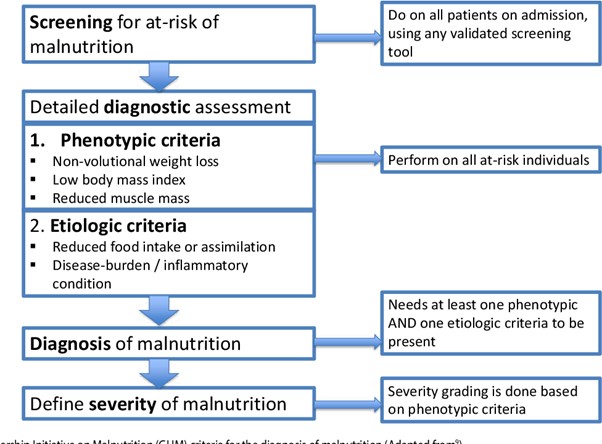
The nurse is caring for a client admitted with chronic kidney disease advancing to stage 4. The nurse should instruct the client to limit the ingestion of which type of foods?
Explanation
Choice A
Apples and blueberries are incorrect. While apples and blueberries are sources of nutrients, they are not as high in potassium as avocados and bananas.
Choice B
Avocados and bananas are correct. Chronic kidney disease (CKD) often requires dietary modifications to manage electrolyte and mineral imbalances. In CKD stage 4, the kidney's ability to filter waste and excess substances from the blood is significantly impaired. Therefore, certain foods that are high in potassium should be limited to prevent hyperkalaemia (elevated blood potassium levels).
Choice C
Cherries and cranberries are incorrect. Cherries and cranberries are also sources of nutrients, but their potassium content is not as high as that of avocados and bananas.
Choice D
Carrots and green beans are incorrect. Carrots and green beans are vegetables that are generally lower in potassium compared to fruits like avocados and bananas.
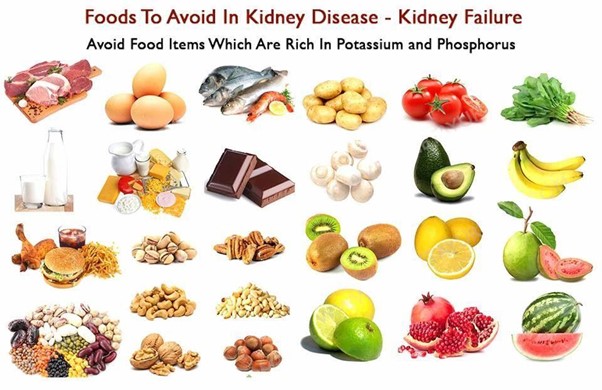
The nurse is caring for a client diagnosed with type 1 diabetes mellitus who uses both short-acting and long-acting insulin adjusted doses throughout the day. Which nutrient is essential for the client to count for each meal and snacks?
Explanation
Choice A
Protein is not essential. While protein can influence blood sugar levels to some extent, its effect is much smaller compared to carbohydrates. Protein is not typically counted as a primary factor in insulin dosing.
Choice B
Carbohydrates are essential. For a client with type 1 diabetes mellitus who uses both short-acting (mealtime) and long-acting (basal) insulin, counting carbohydrates is essential for meal planning and insulin dosing. Carbohydrates have the most direct and significant impact on blood sugar levels. When carbohydrates are consumed, they are broken down into glucose, which enters the bloodstream and can lead to increased blood sugar levels
Choice C
Dairy is not essential. Dairy products can contain carbohydrates (such as lactose), but the carbohydrate content varies and is not as significant as in foods like grains, fruits, and starchy vegetables.
Choice D
Fats are not essential. Fats have minimal direct impact on blood sugar levels. However, they can affect the overall rate of digestion and absorption of carbohydrates, potentially influencing the timing of insulin administration. But carbohydrate counting remains the primary focus for insulin adjustment.
The nurse is caring for an older adult who needs to limit sodium intake. Which food should the nurse encourage the client to avoid?
Explanation
Choice A
Bananas are incorrect. Bananas are naturally low in sodium.
Choice B
Ground sirloin is correct. For an older adult who needs to limit sodium intake, the nurse should encourage avoiding foods that are high in sodium. Processed meats, including ground meats like ground sirloin, are often higher in sodium due to added preservatives and flavourings. These additives can significantly contribute to sodium content. Encouraging the client to choose lean meats and to avoid processed meats can help reduce sodium intake.
Choice C
Cottage cheese is incorrect. While cottage cheese might contain some sodium, it's usually lower in sodium compared to processed meats.
Choice D
Broccoli is incorrect. Broccoli is a vegetable that is naturally low in sodium.
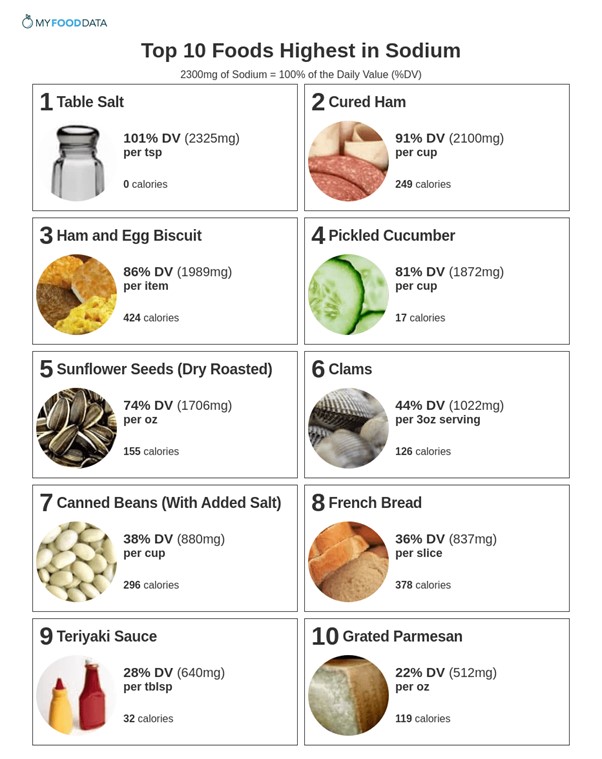
The nurse is performing a nutritional assessment on a client who is professional dancer. Which issue reported by the client should alert the nurse to perform further assessment?
Explanation
Choice A
Sweaty palms are incorrect. Sweaty palms could be a normal response to physical activity and might not necessarily indicate a significant underlying issue.
Choice B
Bunions are incorrect. While bunions can cause discomfort, they might not be directly related to overall health, especially in comparison to fatigue.
Choice C
Dry skin is incorrect. Dry skin could be related to various factors, including environmental conditions or skincare habits. While it's worth addressing, it might not be as immediately concerning as unexplained fatigue.
Choice D
Fatigue is correct. For a professional dancer, fatigue should be an issue that alerts the nurse to perform further assessment. While all of the options can provide information about the client's health, fatigue in a professional dancer could be indicative of various underlying issues that may affect their overall well-being and performance.
Fatigue in a dancer might result from factors such as inadequate nutrition, overtraining, insufficient rest, or underlying medical conditions. It's important for the nurse to explore further to understand the potential causes of the fatigue and address them appropriately.
In performing health screening for a postmenopausal female client, which assessment data indicates the need for referral to a nutritionist?
Reference Range
Total Calcium [Reference Range: Adult 9 to 10.5 mg/dL or 2.25 to 2.62 mmol/L]
High Density Lipoproteins (HDL) [Reference Range: Female: greater than 55 mg/dL or greater than 0.91 mmol/L] Glycosylated haemoglobin (A1C) Reference Range: 4% to 5.9%]
Explanation
Choice A
Serum HDL (high-density lipoprotein) of 35 mg/dL (0.91 mmol/L). Among the options provided, a serum HDL level of 35 mg/dL (0.91 mmol/L) is the assessment data that indicates the need for referral to a nutritionist. HDL is often referred to as "good" cholesterol because it helps remove excess cholesterol from the bloodstream, reducing the risk of cardiovascular disease. In this case, the HDL level of 35 mg/dL is below the recommended reference range for females (greater than 55 mg/dL or greater than 0.91 mmol/L), which could suggest a potential need for dietary and lifestyle interventions to improve cardiovascular health.
Choice B
Serum HbA1c (glycosylated haemoglobin) of 4.8% (0.05) is incorrect. This HbA1c level is within the normal reference range (4% to 5.9%) and indicates good blood sugar control.
Choice C
BMI (body mass index) of 22 kg/m² is incorrect. A BMI of 22 is within the normal weight range and might not necessarily indicate the need for a nutritionist referral.
Choice D
Total serum calcium of 10 mg/dL (2.5 mmol/L) is incorrect. This calcium level is within the normal reference range and might not require a nutritionist referral, unless there are other specific concerns related to calcium intake.
The nurse instructs a client with Type 2 diabetes mellitus (DM) to avoid refined sugar and carbohydrates. Choosing which food indicates that the client understands the diet teaching?
Explanation
Choice A
Potatoes are incorrect. Potatoes are high in carbohydrates and can cause a rapid increase in blood sugar levels, so they are not the best choice for someone with diabetes trying to avoid refined sugars and carbs.
Choice B
Avocado is correct. Avocado is a good choice for someone with Type 2 diabetes who wants to avoid refined sugars and carbohydrates. Avocado is a healthy source of monounsaturated fats, fibre, and various vitamins and minerals. It has a low glycaemic index and doesn't significantly raise blood sugar levels, making it a suitable option for people with diabetes.
Choice C
Grapes is incorrect: Grapes are a fruit with natural sugars, and although they contain fibre, they can still cause spikes in blood sugar levels.
Choice D
Pretzels are incorrect. Pretzels are usually made from refined flour and are high in simple carbohydrates, causing rapid spikes in blood sugar levels. They are not a good choice for someone with diabetes aiming to avoid refined sugars and carbs.
A client expresses an interest in reducing intake of saturated fats and plans to stop eating hamburgers at lunch. Which menu item should the nurse suggest as an alternative source of protein?
Explanation
Choice A
Potatoes are incorrect. Potatoes are high in carbohydrates and can cause a rapid increase in blood sugar levels, so they are not the best choice for someone with diabetes trying to avoid refined sugars and carbs.
Choice B
Avocado is correct. Avocado is a good choice for someone with Type 2 diabetes who wants to avoid refined sugars and carbohydrates. Avocado is a healthy source of monounsaturated fats, fibre, and various vitamins and minerals. It has a low glycaemic index and doesn't significantly raise blood sugar levels, making it a suitable option for people with diabetes.
Choice C
Grapes are incorrect. Grapes are a fruit with natural sugars, and although they contain fibre, they can still cause spikes in blood sugar levels.
Choice D
Pretzels are incorrect. Pretzels are usually made from refined flour and are high in simple carbohydrates, causing rapid spikes in blood sugar levels. They are not a good choice for someone with diabetes aiming to avoid refined sugars and carbs.
The nurse is providing care for a client with an absolute neutrophil count (ANC) of 400. Which action should the nurse perform prior to delivering the meal tray to the client's room?
Reference Range
Neutrophils (ANC) [Reference Range: 2500 to 8000 mm3 or 2500 to 8000 cells/uL]
Explanation
Choice A
Cutting the spaghetti and meatballs into small pieces is inappropriate. This choice is not directly related to the risk of infection. It might be helpful for a client who has difficulty swallowing or chewing, but it doesn't address the compromised immune system and infection risk.
Choice B
Exchanging pasteurized whole milk with skim milk is inappropriate. The type of milk doesn't have a direct impact on infection risk. Both pasteurized whole milk and skim milk are considered safe for consumption. This choice doesn't address the specific concern of infection in a client with a low ANC.
Choice C
Substituting fried potatoes with a garden salad is inappropriate. While choosing healthier food options can be beneficial for overall health, the choice between fried potatoes and a garden salad doesn't necessarily impact the infection risk for a client with a low ANC. This choice also doesn't address the specific concern of infection in this context.
Choice D
Remove the fresh grapes from the meal tray is appropriate. The reason for this choice is that a client with an absolute neutrophil count (ANC) of 400 has a significantly compromised immune system, and they are at a high risk of infection due to their low neutrophil count. Neutrophils are a type of white blood cell that plays a crucial role in fighting off infections. A normal ANC falls within the range of 2500 to 8000 mm3 or cells/uL.
Fresh grapes, being a raw and uncooked food item, may carry a higher risk of containing bacteria or pathogens that could pose a threat to a client with such a low ANC. The nurse needs to ensure that the client's exposure to potential sources of infection is minimized.
Sign Up or Login to view all the 49 Questions on this Exam
Join over 100,000+ nursing students using Nursingprepexams’s science-backend flashcards, practice tests and expert solutions to improve their grades and reach their goals.
Sign Up Now

